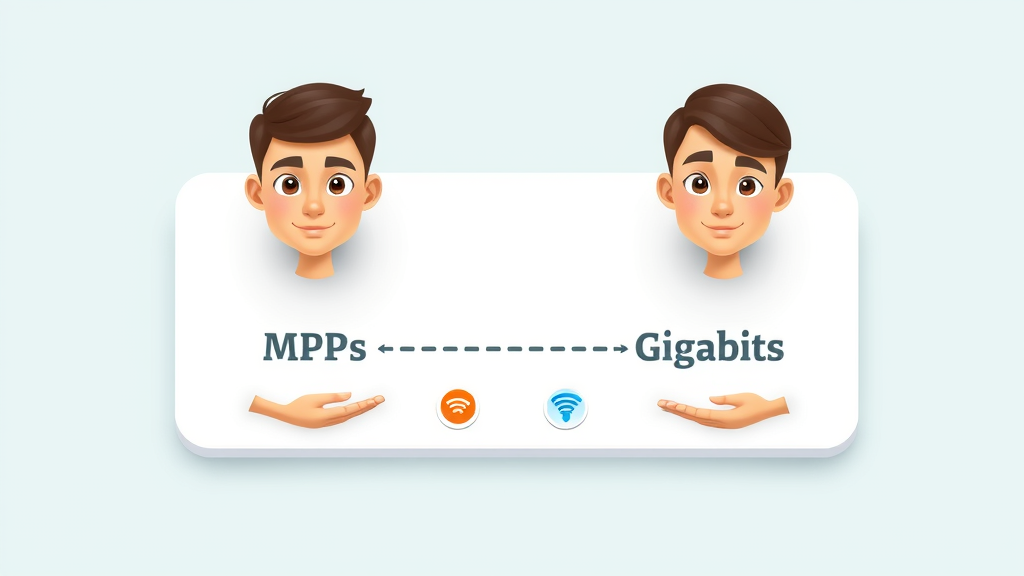Did you know the average UK household consumed over 480GB of data per month in 2023? That’s equivalent to streaming 160 HD movies! With our lives so entwined with the digital world — from work and learning to streaming and gaming — it’s never been more crucial to understand what internet speed means for your home or business. Yet, the jargon around Mbps, Gigabits, and speed tests can feel overwhelming. This practical guide cuts through the confusion, helping you unlock smoother video calls, quicker downloads, and hassle-free online gaming, no matter if you’re in a bustling city or a quiet village.
Startling Facts: How Internet Speed Impacts Everyday Life and Work
The way you experience the internet — whether streaming on Netflix, making a video call on Zoom, or running an online business — depends almost entirely on your internet speed. For families in the UK, slow broadband speeds can cause pixelated video calls, frustrating buffering on streaming services, and lag in online gaming. For businesses, sluggish download speed and upload speed translates into lost productivity and missed opportunities.
With social media, remote work, online games, and streaming services constantly demanding more bandwidth, understanding your broadband speed is not just technical jargon — it’s an essential part of daily life. In fact, many are not even getting the fast broadband they pay for, due to unoptimised equipment, poor router location, or even ISP throttling. That makes knowing how to run an internet speed test — and interpret speed test results — a must for every homeowner and business property owner hoping to get the best experience from their broadband connection.

"Did you know the average UK household consumed over 480GB of data per month in 2023? That’s equivalent to streaming 160 HD movies!" – Ofcom Annual Report
What You'll Learn: Your Guide to Internet Speed, Broadband Speed, and More
- Understand what Mbps, Gigabits, and broadband speed truly measure
- How to perform an internet speed test and interpret your speed test results
- The impact of download speed and upload speed on streaming, gaming, and business
- Tips on getting accurate results and improving your broadband connection
Defining Internet Speed: The Basics for Homeowners and Businesses
What is Internet Speed? Mbps, Gigabits, and the Broadband Speed Equation
Let’s start with the basics: Internet speed is the rate at which data travels from the internet to your device, measured most commonly in megabits per second (Mbps) and sometimes in Gigabits per second (Gbps). In simple terms, the higher your Mbps or Gbps, the faster you can stream movies, join video calls, play online games, or upload files to the cloud. For most users in the UK, a speed test will reveal your current download speed (how fast you get data from the internet) and upload speed (how fast you send data online, such as during video calls or uploading to social media).
It’s easy to be confused by the terminology: one Gigabit equals 1,000 Megabits, and internet providers advertise packages in either Mbps or Gbps. Knowing these terms is crucial for comparing broadband deals and setting realistic expectations for your internet connection. Whether you’re looking for the fastest fibre broadband available in your area or simply want reliable speeds for work and play, understanding Mbps and Gigabits puts you in control. So, the next time you run a speed check, you’ll know exactly what those numbers mean and how they affect your digital life.

Why Internet Speed Matters: Streaming, Working, and Everyday Use Cases
Your internet speed isn’t just a number on a bill — it defines your experience using the internet at home and work. A higher download speed means HD streaming without buffering, large files downloaded in seconds, and seamless social media usage. On the flip side, a slow broadband connection can turn a simple Zoom video call into a pixelated, laggy mess, or leave your family arguing over who gets the bandwidth for online gaming versus watching TV.
Businesses need robust upload speeds for video conferencing, cloud backups, and rapid sharing of files. Even social media posts or running a successful home-based business often rely on both strong download speeds and upload speed. The key is choosing the right broadband speed for your lifestyle — and regularly running an internet speed test to make sure you’re getting what you pay for. When you understand the essentials, you can finally say goodbye to buffering icons and work interruptions. If you want to dive deeper into practical steps for checking your connection, our guide on using speed tests to assess your broadband performance offers actionable tips for UK households.
| Speed Tier | Common Internet Activities | Recommended Users/Usage |
|---|---|---|
| 10–30 Mbps | Email, social media, basic browsing, SD streaming | Individuals or light users |
| 30–100 Mbps | HD streaming, video calls, online gaming | Average UK households (2–4 people) |
| 100–500 Mbps | Multiple 4K streams, large file downloads/uploads | Busy families or small businesses |
| 1 Gbps (1,000 Mbps) or more | Heavy usage: remote work, big data transfers, many connected devices | Large families, shared flats, businesses |
Broadband Speed Explained: What Every Home and Business Should Know
Types of Broadband Connection and Their Typical Internet Speeds
Not all broadband connections are created equal, and the technology you use significantly impacts your available internet speeds. Understanding the difference helps when shopping for a better broadband deal and ensuring you get fast, reliable access. Here are the main options you’ll encounter in the UK:
- Fibre: The gold standard for speed and reliability, fibre broadband uses fibre-optic cables to deliver high speeds, often advertised from 30 Mbps to well over 1 Gbps. Most new UK homes have fibre available in your area, but coverage may vary.
- ADSL: An older technology, ADSL runs over your home’s telephone line and usually tops out between 10–20 Mbps — suitable for basic browsing but not for heavy streaming or work-from-home needs.
- Cable: Cable broadband utilises coaxial cables and typically offers higher download speeds than ADSL, often in the range of 50–350 Mbps. Available mostly in larger towns and cities.
- Mobile Broadband: Using 4G or 5G networks, mobile broadband delivers flexibility and can achieve impressive speeds (especially with 5G), but performance may fluctuate with coverage and local congestion.

How to Find the Best Broadband Deal Based on Your Internet Speed Needs
Choosing the right broadband deal starts with matching the package speed to your household or business activities. Are you simply checking emails and using social media, or do you have gamers and home workers who regularly join video calls? To get fast and reliable download speed, compare packages and check the upload speed as well, which is vital for video calls, cloud storage, and sending large files. Always run a speed check or internet speed test on your existing connection before switching — real-world speeds can differ from what’s advertised.
It’s a good idea to review test results from reputable speed checker tools to benchmark your current service. Before signing up for a new broadband package, ask the provider for estimated speeds available in your area and clarify policies around speed guarantees or compensation for under-performance. Remember, the "cheapest" deal isn’t always the best if it doesn’t meet your download speeds and performance needs.
Speed Tests: How to Use an Internet Speed Test and Interpret Accurate Results
What is a Speed Test and When Should You Use a Broadband Speed Test?
An internet speed test or broadband speed test is a simple, quick way to measure the performance of your internet connection. Using a reputable speed checker website, you can determine your actual download speed, upload speed, and latency (the time it takes for data to travel). Running a speed test is helpful when you’re experiencing slowdowns, before switching broadband providers, or even just to make sure you’re getting the service you pay for.
You should perform a speed check at different times of day and with as few connected devices as possible for the most accurate result. Understanding your test results is crucial — they reveal if your provider is delivering on their promise and help you pinpoint if issues are due to your broadband speeds or something else, such as Wi-Fi interference. Never hesitate to share your findings with your provider, especially if you consistently get slower speeds than advertised.
Speed Test Results: Download Speed vs Upload Speed Explained
The two main numbers on a typical speed test result are download speed and upload speed. Download speed affects how quickly you can stream, browse, and get files from the internet, while upload speed is all about how fast you can send data. In the UK, most broadband deals prioritise download speeds, but as more people work from home and use social media, a good upload speed has become just as important.
Example: If your speed test shows a download speed of 50 Mbps and an upload speed of 5 Mbps, you’ll watch Netflix in HD without issues, but uploading large projects or sharing videos on social media will take longer. Consistently low upload speed can impact video calls, online gaming, and file uploads for businesses and home users alike. Always review your test results to understand whether you should aim for a faster speed from your next broadband deal.
| Connection Type | Download Speed (Mbps) | Upload Speed (Mbps) | Latency (ms) | Best Uses |
|---|---|---|---|---|
| ADSL | 12 | 1 | 35 | Email, browsing, light social media |
| Cable | 80 | 10 | 21 | Streaming, gaming, remote learning |
| Fibre (FTTC) | 150 | 20 | 15 | Multiple 4K streams, video calls, cloud work |
| Full Fibre (FTTP) | 900 | 100 | 11 | Home business, many devices, heavy uploads |
Speed Checker Tools: Finding Reliable Broadband Speed Test Websites
Not all speed checkers are created equal! To get the most accurate result, use reputable sites like Speedtest.net, Fast.com, or your broadband provider’s own speed checker platform. Moreover, the most accurate results are obtained when you connect your device directly to the router with a cable, disable background downloads, and test at various times of day. This way, you capture both the best-case and worst-case performance of your broadband connection.
Most broadband speed test sites present results in Mbps, so you can compare them with advertised speeds or other providers. If your average speeds consistently fall short, it may be time to negotiate with your ISP or look for a new broadband deal for faster internet speed. Taking screenshots of your test results helps when seeking support or compensation for slowdowns.
Factors Affecting Your Internet Speed and Broadband Connection
Common Issues Slowing Down Your Broadband Speeds: A Checklist
Slow broadband speeds are rarely random. They’re often caused by a few familiar culprits, many of which you can diagnose and fix yourself before calling your provider. Here’s a checklist of issues that can sabotage your internet speed, whether at home or in your business:
- Wi-Fi interference: Other electronic devices or thick walls can disrupt your wireless signal and lead to spotty broadband speed.
- Number of connected devices: The more phones, tablets, and TVs connected to your network, the more each device shares your available speed, sometimes dropping everyone’s performance.
- Router location: Placing your router in a cupboard or behind thick furniture can impair your Wi-Fi. The central, open location is best for the strongest speeds throughout your property.
- ISP throttling: Some providers slow down your connection during peak times or if you’ve exceeded a hidden data cap — not always obvious but very frustrating.
- Outdated equipment: Older routers and devices may not support fast broadband, holding back your actual speeds even if you pay for a premium package.
Tips for Getting Accurate Results Every Time You Check Your Internet Speed
It’s easy to run a speed test, but getting accurate results takes a little know-how. To get the most reliable outcome, always disconnect unnecessary devices from your network during testing, use a direct wired connection if possible, and avoid running speed checks during peak evening hours when your local area might be busy. For business property owners, schedule tests outside work hours to measure your true available business broadband speed.
If you suspect your connection is underperforming despite following these tips, collect test results over several days and present them to your internet provider. This consistent tracking helps hold your provider accountable and may win you a better broadband deal or a fix for your broadband connection. Remember: Regular speed checks are essential to ensure you’re getting the service you pay for, advises broadband expert Sarah McKay.
"Regular speed checks are essential to ensure you’re getting the service you pay for," advises broadband expert Sarah McKay.
Comparing Broadband Speed Packages in the UK: What to Look Out For
The broadband market is crowded, so how do you compare packages and not get lost in the jargon? Start by focusing on what matters: download speed, upload speed, contract length, and price. Many providers offer introductory discounts, but the best experience comes from matching your usage needs with the true speed delivered to your home or business. Always compare advertised speeds with verified speed test results to ensure accuracy.
Look out for details like setup costs, compensation guarantees, and review the provider’s history of reliable speeds in your area. The cheapest package may not provide enough bandwidth for high-definition video calls, online gaming, and multiple devices, while a pricier "ultrafast" offer may be overkill for casual surfers. Customer service reputation is another important, but often overlooked, consideration.
| Provider | Package Name | Download Speed (Mbps) | Upload Speed (Mbps) | Monthly Price (£) |
|---|---|---|---|---|
| BT | Fibre Essential | 36 | 10 | £28.99 |
| Virgin Media | M125 Fibre | 132 | 20 | £28.00 |
| Sky | Superfast | 61 | 16 | £24.00 |
| TalkTalk | Fibre 65 | 67 | 18 | £26.00 |
| Hyperoptic | Full Fibre 500 | 500 | 50 | £35.00 |

People Also Ask: Internet Speed FAQs
What is a good internet speed for working from home?
For most remote workers in the UK, a minimum of 25–50 Mbps download speed and at least 5–10 Mbps upload speed is recommended. This allows you to make smooth video calls, download files quickly, and access cloud apps without interruptions. If your work involves heavy uploads, such as sharing large files or hosting webinars, consider a fibre broadband deal with higher upload speeds for the best experience – especially if others in the house are using the internet at the same time.
How can I check my broadband speed accurately?
For an accurate result, connect your computer directly to your router using an Ethernet cable rather than Wi-Fi. Close all background applications and disconnect unnecessary devices. Use a reliable speed checker website, such as Speedtest.net, and run tests at several times throughout the day. Compare these measurements to your provider’s advertised broadband speeds. If your results are significantly lower, contact your provider or consider switching to a new broadband deal.

Why might my broadband speed be slower than advertised?
Your broadband speed can be slower due to several common issues: peak-time congestion, Wi-Fi interference, too many connected devices, outdated routers, or your provider throttling bandwidth. Your property’s location and wiring quality also make a difference. Running regular speed tests and maintaining your equipment helps ensure you’re getting the best possible service, and lets you report slow speeds to your ISP for support or troubleshooting.
What is the difference between download speed and upload speed?
Download speed is how quickly you can receive or pull data from the internet, affecting streaming and browsing. Upload speed is the rate at which you can send data out, critical for video calls, file uploads, and sharing content. Most UK broadband deals have higher download than upload speeds, but as remote work rises, upload speed is becoming increasingly important for both businesses and home users.
Key Takeaways: Making Sense of Internet Speed for Your Life and Work
- Mbps and Gigabits define your data experience at home and work
- Speed tests and accurate results empower you to demand better broadband
- Download speed and upload speed impact everything from Netflix to Zoom
- Choosing the right broadband speed saves you money and hassle
Conclusion: Your Next Steps for Better Broadband Speed and Internet Speed Performance

Take charge of your internet speed by understanding what Mbps and Gigabits mean, testing regularly, and choosing broadband that matches your needs. A great online experience is just a speed check away.
If you’re interested in how digital connectivity fits into the bigger picture of property ownership, you might also enjoy our essential guide on spotting neighbour red flags when buying a home. It’s packed with strategic insights for homebuyers, helping you make informed decisions not just about broadband, but about the overall quality of your next property investment. Explore more to ensure your next move is both digitally and socially savvy.
We'd Love to See Your Comments on This!
Understanding internet speed is crucial for optimizing your online experience. To delve deeper into this topic, consider exploring the following resources:
-
“Internet Speed Statistics 2025”: This comprehensive report provides insights into internet usage and availability in the United States, highlighting trends and statistics that can help you understand how internet speeds impact daily activities. (highspeedinternet.com)
-
“What is a Good Internet Speed? Internet Speed Classifications”: This guide explains internet speed classifications and offers recommendations on the speeds required for various online activities, assisting you in determining the optimal internet speed for your needs. (allconnect.com)
If you’re serious about enhancing your internet experience, these resources will provide valuable information to help you make informed decisions.
 Add Row
Add Row  Add
Add 





Write A Comment